
Messier 59 or M59, also known as NGC 4621, is an elliptical galaxy in the equatorial constellation of Virgo. It is a member of the Virgo Cluster, with the nearest fellow member 8′ away and around 5 magnitudes fainter. The nearest cluster member of comparable brightness is the lenticular galaxy NGC 4638, which is around 17′ away. It and the angularly nearby elliptical galaxy Messier 60 were both discovered by Johann Gottfried Koehler in April 1779 when observing comet seeming close by. Charles Messier listed both in the Messier Catalogue about three days after Koehler's discovery.
A Hickson Compact Group is a collection of galaxies designated as published by Paul Hickson in 1982.
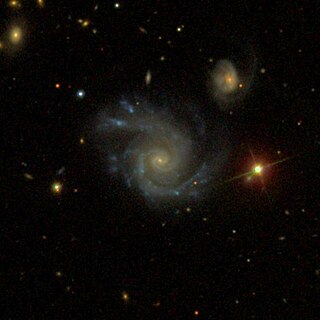
NGC 5829 is a spiral galaxy located in the constellation Boötes. It is 281 million light-years away from Earth and was discovered by astronomer, Edouard Stephan in May 1882.

NGC 3718, also called Arp 214, is a galaxy located approximately 52 million light years from Earth in the constellation Ursa Major. It is either a lenticular or spiral galaxy.
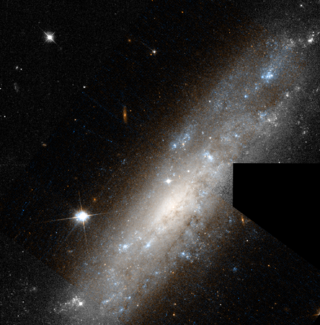
NGC 1003 is a spiral galaxy at the western edge of the Perseus constellation. It is located at a distance of about 36 million light years from the Milky Way and is receding with a heliocentric radial velocity of 624 km/s. This galaxy was discovered by the Anglo-German astronomer William Herschel on October 6, 1784, who described it as "pretty faint, large, extended 90°±, much brighter middle, mottled but not resolved". It is a member of the NGC 1023 group of galaxies.
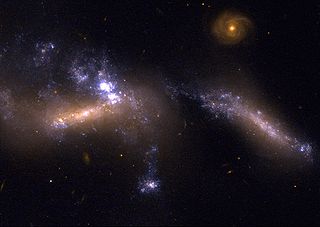
NGC 1741 is a distant pair of interacting galaxies in the Eridanus constellation. It was discovered on 6 January 1878 by French astronomer Édouard Stephan. As a result of the collision, the galaxies are in a rapid starburst phase. The galaxies are classed as Wolf–Rayet galaxies due to their high content of rare Wolf–Rayet stars.

NGC 536 is a barred spiral galaxy located in the constellation Andromeda. It is located at a distance of circa 200 million light-years from Earth, which, given its apparent dimensions, means that NGC 536 is about 180,000 light years across. It was discovered by William Herschel on September 13, 1784. It is a member of Hickson Compact Group 10, which also includes the galaxies NGC 529, NGC 531, and NGC 542. It belongs to the Perseus–Pisces Supercluster.

NGC 5965 is a spiral galaxy located in the constellation Draco. It is located at a distance of circa 150 million light years from Earth, which, given its apparent dimensions, means that NGC 5965 is about 260,000 light years across. It was discovered by William Herschel on May 5, 1788.

NGC 7674 is a spiral galaxy located in the constellation Pegasus. It is located at a distance of about 350 million light years from Earth, which, given its apparent dimensions, means that NGC 7674 is about 125,000 light years across. It was discovered by John Herschel on August 16, 1830.

NGC 753 is a spiral galaxy located 220 million light-years away in the constellation Andromeda. The galaxy was discovered by astronomer by Heinrich d'Arrest on September 16, 1865 and is a member of Abell 262.

NGC 759 is an elliptical galaxy located 230 million light-years away in the constellation Andromeda. NGC 759 was discovered by astronomer by Heinrich d'Arrest on September 17, 1865. It is a member of Abell 262.
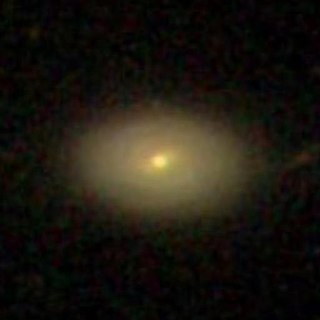
NGC 4060 is a lenticular galaxy located 320 million light-years away in the constellation Coma Berenices. It was discovered by astronomer Albert Marth on March 18, 1865 and is a member of the NGC 4065 Group which is part of the Coma Supercluster.

NGC 4061 is an elliptical galaxy located 310 light-years away in the constellation Coma Berenices. It was discovered by astronomer William Herschel on April 27, 1785. It was rediscovered by John Herschel on April 29, 1832. It is listed both as NGC 4061 and NGC 4055. NGC 4061 is a member of the NGC 4065 Group and forms an interacting pair with its companion, NGC 4065 as evidenced by distortions in their optical isophotes.

NGC 4070 is an elliptical galaxy located 340 million light-years away in the constellation Coma Berenices. NGC 4070 was discovered by astronomer William Herschel on April 27, 1785. It was rediscovered by John Herschel on April 29, 1832 and was listed as NGC 4059. The galaxy is a member of the NGC 4065 Group.

NGC 4076 is a spiral galaxy located 290 million light-years away in the constellation Coma Berenices. The galaxy was discovered by astronomer William Herschel on April 27, 1785 and is a member of the NGC 4065 Group.

NGC 4090 is a spiral galaxy located 340 million light-years away in the constellation Coma Berenices. The galaxy was discovered by astronomer Heinrich d'Arrest on May 2, 1864 and is a member of the NGC 4065 Group.

NGC 4098 is an interacting pair of spiral galaxies located 330 million light-years away in the constellation Coma Berenices. NGC 4098 was discovered by astronomer William Herschel on April 26, 1785. It was then rediscovered by Hershel on December 27, 1786 was listed as NGC 4099. NGC 4098 is a member of the NGC 4065 Group.

NGC 4299 is a featureless spiral galaxy located about 55 million light-years away in the constellation Virgo. It was discovered by astronomer William Herschel on March 15, 1784 and is a member of the Virgo Cluster.
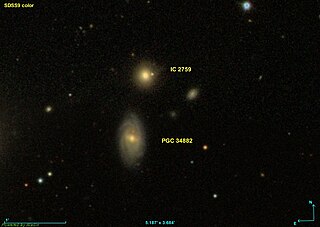
IC 2759 is a small type E elliptical galaxy located in the constellation of Leo. It is located 350 million light-years away from the Solar System and was discovered on April 24, 1897, by Guillaume Bigourdan. Sometimes IC 2759 is confused with the spiral galaxy, PGC 34882 which is located south of the galaxy.
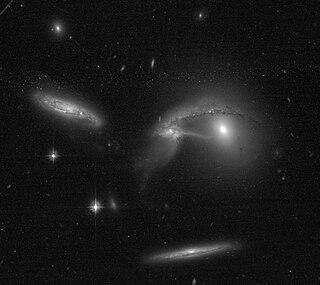
NGC 7609 or known as Arp 150 and HCG 95A, is a large elliptical galaxy located in Pegasus. Its speed relative to the cosmic microwave background is 11,879 km/s, which corresponds the galaxy to be located 554 million light-years away from Earth. NGC 7609 was discovered on October 5, 1864, by Albert Marth and included in Halton Arp's, Atlas of Peculiar Galaxies in galaxies that produces jets.



















